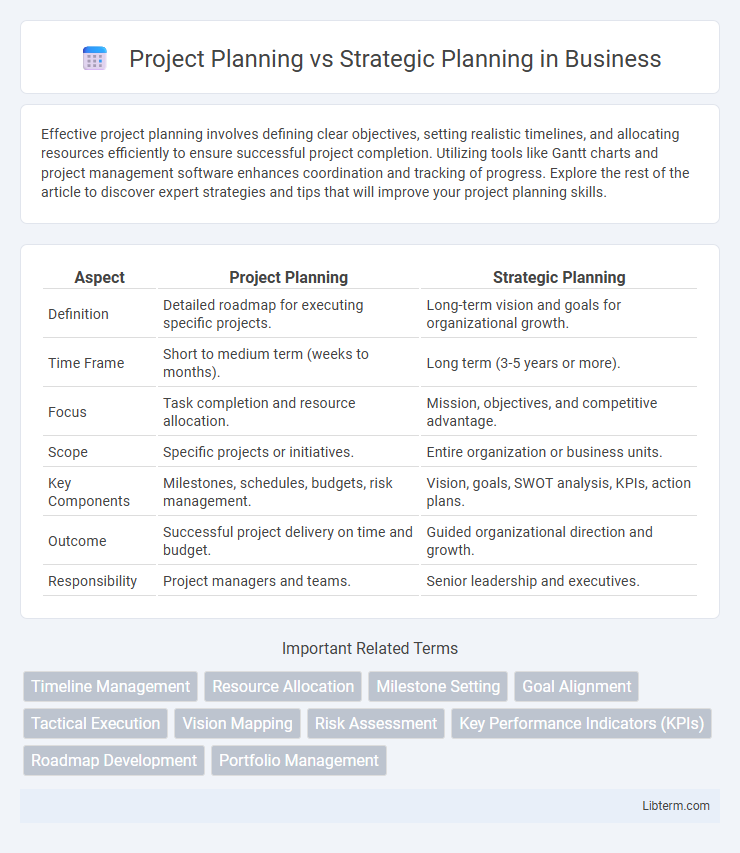Effective project planning involves defining clear objectives, setting realistic timelines, and allocating resources efficiently to ensure successful project completion. Utilizing tools like Gantt charts and project management software enhances coordination and tracking of progress. Explore the rest of the article to discover expert strategies and tips that will improve your project planning skills.
Table of Comparison
| Aspect | Project Planning | Strategic Planning |
|---|---|---|
| Definition | Detailed roadmap for executing specific projects. | Long-term vision and goals for organizational growth. |
| Time Frame | Short to medium term (weeks to months). | Long term (3-5 years or more). |
| Focus | Task completion and resource allocation. | Mission, objectives, and competitive advantage. |
| Scope | Specific projects or initiatives. | Entire organization or business units. |
| Key Components | Milestones, schedules, budgets, risk management. | Vision, goals, SWOT analysis, KPIs, action plans. |
| Outcome | Successful project delivery on time and budget. | Guided organizational direction and growth. |
| Responsibility | Project managers and teams. | Senior leadership and executives. |
Understanding Project Planning
Project planning involves defining specific objectives, timelines, resources, and tasks required to achieve a particular goal within a project. It focuses on detailed scheduling, risk assessment, and resource allocation to ensure successful project execution and completion. Effective project planning integrates scope management and milestone tracking to align team efforts with anticipated deliverables.
Defining Strategic Planning
Strategic planning involves establishing long-term goals and setting a comprehensive vision that guides an organization's direction over several years. It prioritizes resource allocation and competitive positioning to achieve sustainable growth and market advantage. Unlike project planning, which focuses on short-term execution and task management, strategic planning emphasizes broader business objectives and aligning initiatives with the company's mission and values.
Key Differences Between Project Planning and Strategic Planning
Project planning centers on defining specific tasks, timelines, and resource allocations necessary to achieve short-term objectives within a project's scope. Strategic planning involves setting long-term organizational goals, analyzing internal and external environments, and formulating broad approaches to ensure sustainable growth and competitive advantage. The key differences lie in their time horizons, level of detail, and focus: project planning is tactical and operational, while strategic planning is visionary and directional.
Objectives: Short-Term vs Long-Term Goals
Project planning targets specific short-term objectives with clear deliverables, timelines, and resource allocations designed to complete individual projects successfully. Strategic planning focuses on long-term goals, setting a broad vision and direction for the organization over several years to ensure sustainable growth and competitive advantage. By prioritizing immediate project outcomes in project planning and overarching organizational aims in strategic planning, each approach serves distinct but complementary purposes in goal achievement.
Scope and Focus: Narrow vs Broad
Project planning concentrates on defining a narrow scope, targeting specific tasks, timelines, and resource allocation to achieve particular objectives within a set framework. Strategic planning adopts a broad focus, encompassing long-term goals, organizational vision, and alignment across multiple projects to drive overall growth and competitive advantage. The distinct difference lies in project planning's detail-oriented execution versus strategic planning's wide-ranging perspective on organizational success.
Planning Processes and Methodologies
Project planning involves defining specific tasks, timelines, resource allocations, and milestones to successfully complete individual projects, utilizing methodologies such as Waterfall, Agile, or Critical Path Method for efficient workflow management. Strategic planning focuses on long-term organizational goals, market positioning, competitive analysis, and resource prioritization to drive overall business growth, often employing frameworks like SWOT analysis, Balanced Scorecard, and OKRs for aligning initiatives with corporate vision. Both processes require continuous monitoring and adjustment, but project planning centers on tactical execution while strategic planning emphasizes high-level decision-making and future-oriented outcomes.
Decision-Making Approaches
Project planning emphasizes tactical decision-making focused on resource allocation, timelines, and task dependencies to achieve specific deliverables within a defined scope. Strategic planning involves high-level decisions that align organizational goals with long-term vision, market trends, and competitive positioning. Effective decision-making in project planning requires real-time adjustments and risk management, while strategic planning demands scenario analysis and prioritization of initiatives for sustained growth.
Role in Organizational Success
Project planning drives organizational success by outlining specific tasks, timelines, and resources needed to achieve short-term objectives, ensuring efficient execution and measurable outcomes. Strategic planning establishes a long-term vision, allocates resources effectively, and sets priorities to guide overall growth and competitive positioning. Both functions are essential; project planning delivers tactical achievements while strategic planning ensures alignment with broader organizational goals.
Common Challenges in Implementation
Project planning and strategic planning often face common implementation challenges such as inadequate resource allocation, unclear communication channels, and resistance to change. Both require aligning goals with available capabilities, yet misalignment frequently leads to missed deadlines and budget overruns. Effective stakeholder engagement and continuous progress monitoring are critical to overcoming these obstacles and ensuring successful execution.
When to Use Project Planning vs Strategic Planning
Project planning is best used when defining detailed steps, timelines, and resource allocation for specific, short-term initiatives with clear objectives and deliverables. Strategic planning focuses on long-term goals, organizational vision, and broad priorities, guiding overall direction and decision-making over multiple years. Use project planning for tactical execution of defined projects, while strategic planning is essential for setting sustainable competitive advantage and aligning all projects with overarching business aims.
Project Planning Infographic

 libterm.com
libterm.com